Financial Accounting Theory: Fair Value Accounting Analysis Report
VerifiedAdded on 2023/02/01
|10
|2266
|97
Report
AI Summary
This report provides a critical analysis of fair value accounting (FVA), exploring its theoretical underpinnings, practical applications, and implications for financial reporting. The report begins with a literature review that defines FVA, highlighting its historical context and relevance in a globalized economy. It delves into the advantages of FVA, such as timely information, accurate valuation, measuring true income, and aiding survival during economic downturns. Conversely, the report also examines the disadvantages, including the potential for manipulation, investor dissatisfaction, and downward valuation. The report then details the three-tier process used in fair value estimation, emphasizing the importance of market-based measures. Finally, the report discusses the qualitative characteristics considered in FVA, such as faithful representation, relevance, comparability, understandability, and timeliness, providing a comprehensive overview of how these characteristics impact the reliability and usefulness of financial information. The report is based on the academic article written by Antonio Marra.
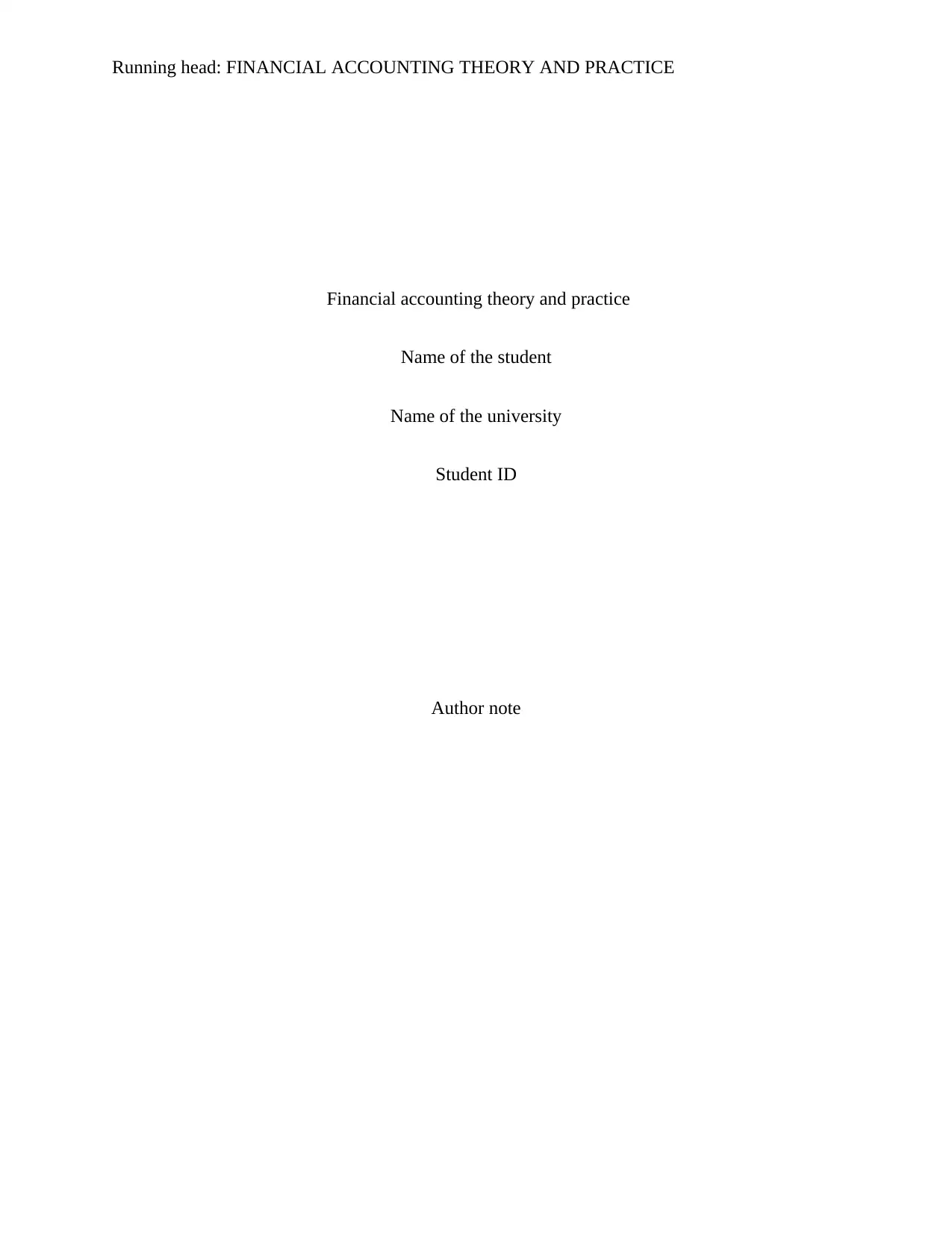
Running head: FINANCIAL ACCOUNTING THEORY AND PRACTICE
Financial accounting theory and practice
Name of the student
Name of the university
Student ID
Author note
Financial accounting theory and practice
Name of the student
Name of the university
Student ID
Author note
Paraphrase This Document
Need a fresh take? Get an instant paraphrase of this document with our AI Paraphraser
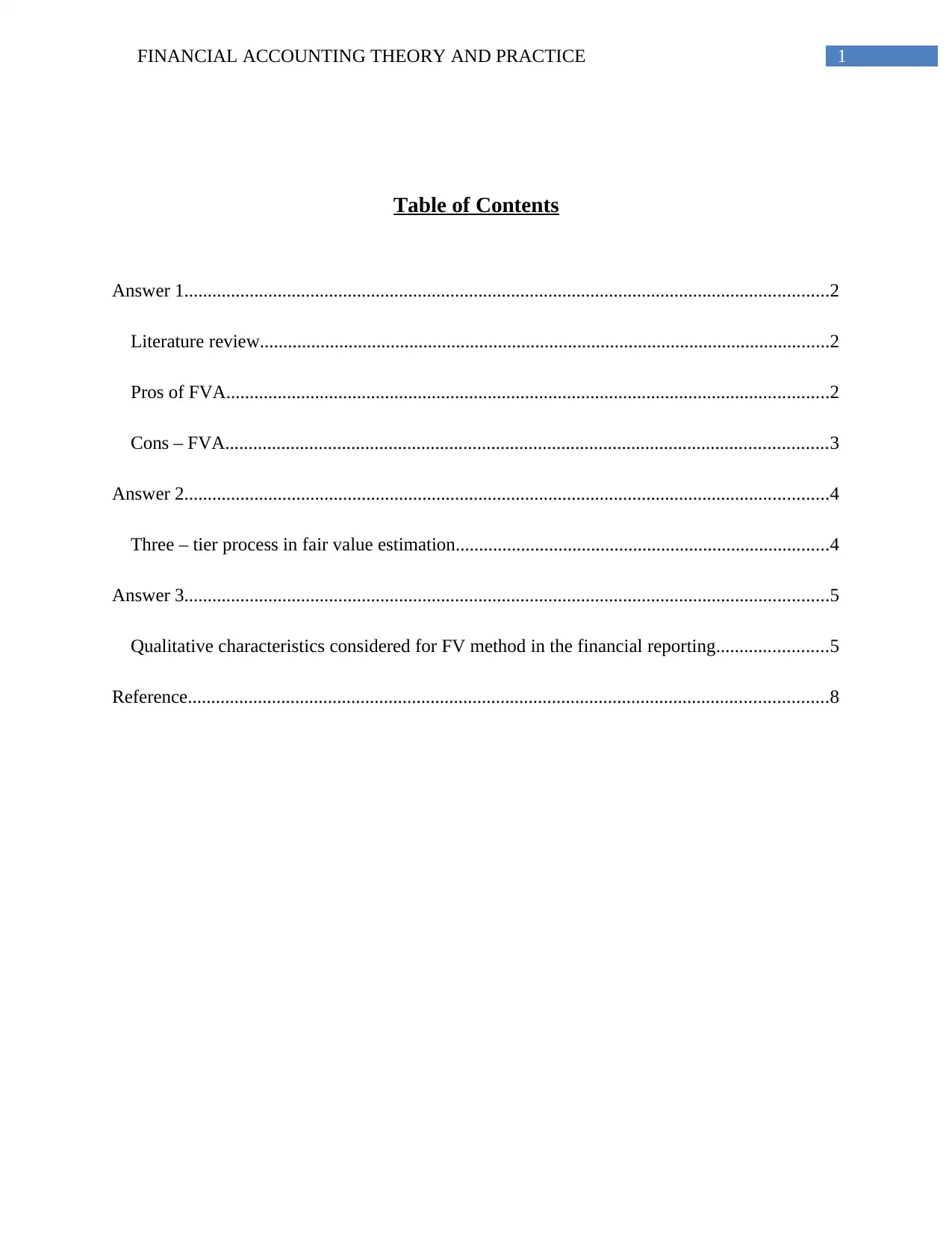
1FINANCIAL ACCOUNTING THEORY AND PRACTICE
Table of Contents
Answer 1..........................................................................................................................................2
Literature review..........................................................................................................................2
Pros of FVA.................................................................................................................................2
Cons – FVA.................................................................................................................................3
Answer 2..........................................................................................................................................4
Three – tier process in fair value estimation................................................................................4
Answer 3..........................................................................................................................................5
Qualitative characteristics considered for FV method in the financial reporting........................5
Reference.........................................................................................................................................8
Table of Contents
Answer 1..........................................................................................................................................2
Literature review..........................................................................................................................2
Pros of FVA.................................................................................................................................2
Cons – FVA.................................................................................................................................3
Answer 2..........................................................................................................................................4
Three – tier process in fair value estimation................................................................................4
Answer 3..........................................................................................................................................5
Qualitative characteristics considered for FV method in the financial reporting........................5
Reference.........................................................................................................................................8
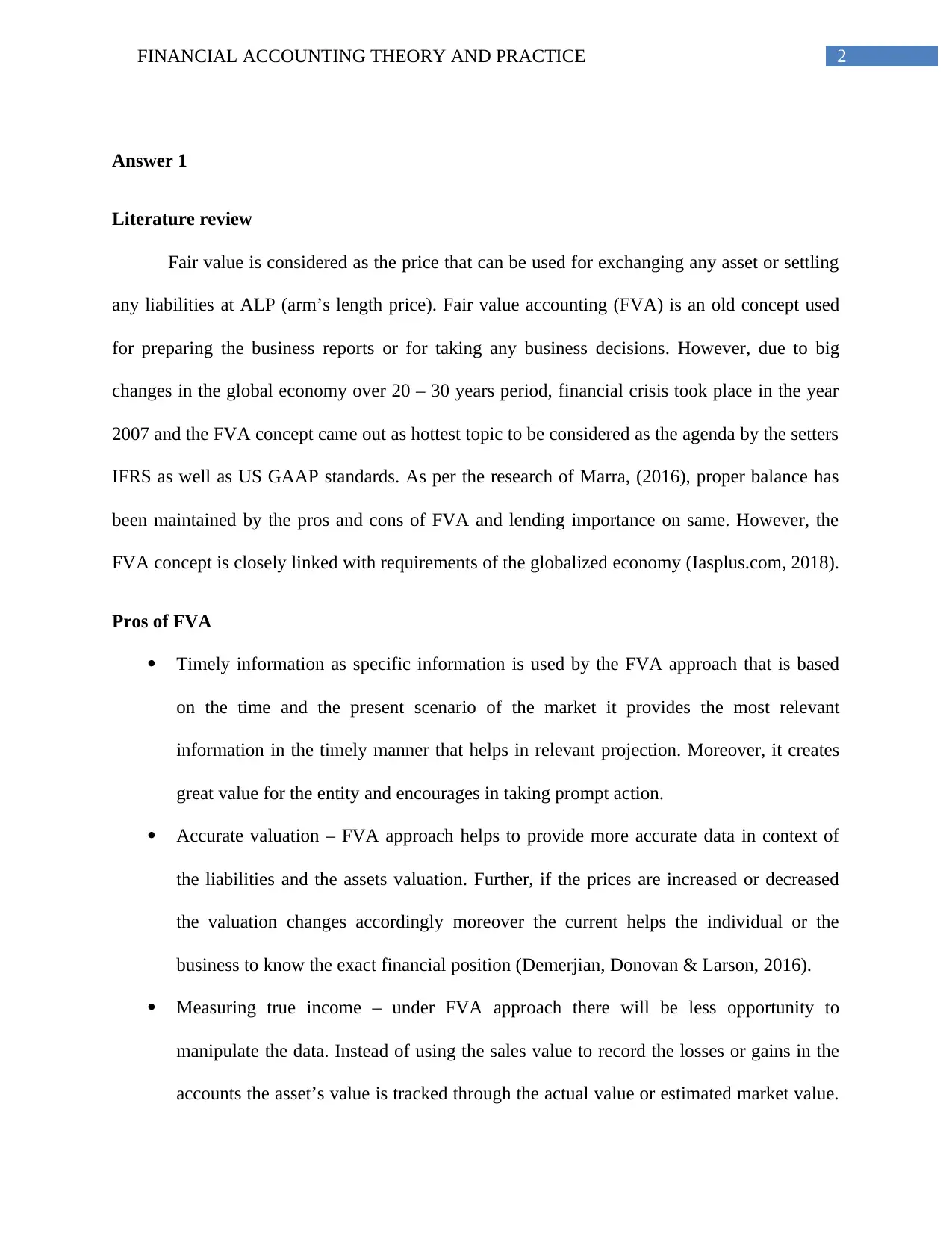
2FINANCIAL ACCOUNTING THEORY AND PRACTICE
Answer 1
Literature review
Fair value is considered as the price that can be used for exchanging any asset or settling
any liabilities at ALP (arm’s length price). Fair value accounting (FVA) is an old concept used
for preparing the business reports or for taking any business decisions. However, due to big
changes in the global economy over 20 – 30 years period, financial crisis took place in the year
2007 and the FVA concept came out as hottest topic to be considered as the agenda by the setters
IFRS as well as US GAAP standards. As per the research of Marra, (2016), proper balance has
been maintained by the pros and cons of FVA and lending importance on same. However, the
FVA concept is closely linked with requirements of the globalized economy (Iasplus.com, 2018).
Pros of FVA
Timely information as specific information is used by the FVA approach that is based
on the time and the present scenario of the market it provides the most relevant
information in the timely manner that helps in relevant projection. Moreover, it creates
great value for the entity and encourages in taking prompt action.
Accurate valuation – FVA approach helps to provide more accurate data in context of
the liabilities and the assets valuation. Further, if the prices are increased or decreased
the valuation changes accordingly moreover the current helps the individual or the
business to know the exact financial position (Demerjian, Donovan & Larson, 2016).
Measuring true income – under FVA approach there will be less opportunity to
manipulate the data. Instead of using the sales value to record the losses or gains in the
accounts the asset’s value is tracked through the actual value or estimated market value.
Answer 1
Literature review
Fair value is considered as the price that can be used for exchanging any asset or settling
any liabilities at ALP (arm’s length price). Fair value accounting (FVA) is an old concept used
for preparing the business reports or for taking any business decisions. However, due to big
changes in the global economy over 20 – 30 years period, financial crisis took place in the year
2007 and the FVA concept came out as hottest topic to be considered as the agenda by the setters
IFRS as well as US GAAP standards. As per the research of Marra, (2016), proper balance has
been maintained by the pros and cons of FVA and lending importance on same. However, the
FVA concept is closely linked with requirements of the globalized economy (Iasplus.com, 2018).
Pros of FVA
Timely information as specific information is used by the FVA approach that is based
on the time and the present scenario of the market it provides the most relevant
information in the timely manner that helps in relevant projection. Moreover, it creates
great value for the entity and encourages in taking prompt action.
Accurate valuation – FVA approach helps to provide more accurate data in context of
the liabilities and the assets valuation. Further, if the prices are increased or decreased
the valuation changes accordingly moreover the current helps the individual or the
business to know the exact financial position (Demerjian, Donovan & Larson, 2016).
Measuring true income – under FVA approach there will be less opportunity to
manipulate the data. Instead of using the sales value to record the losses or gains in the
accounts the asset’s value is tracked through the actual value or estimated market value.
⊘ This is a preview!⊘
Do you want full access?
Subscribe today to unlock all pages.

Trusted by 1+ million students worldwide
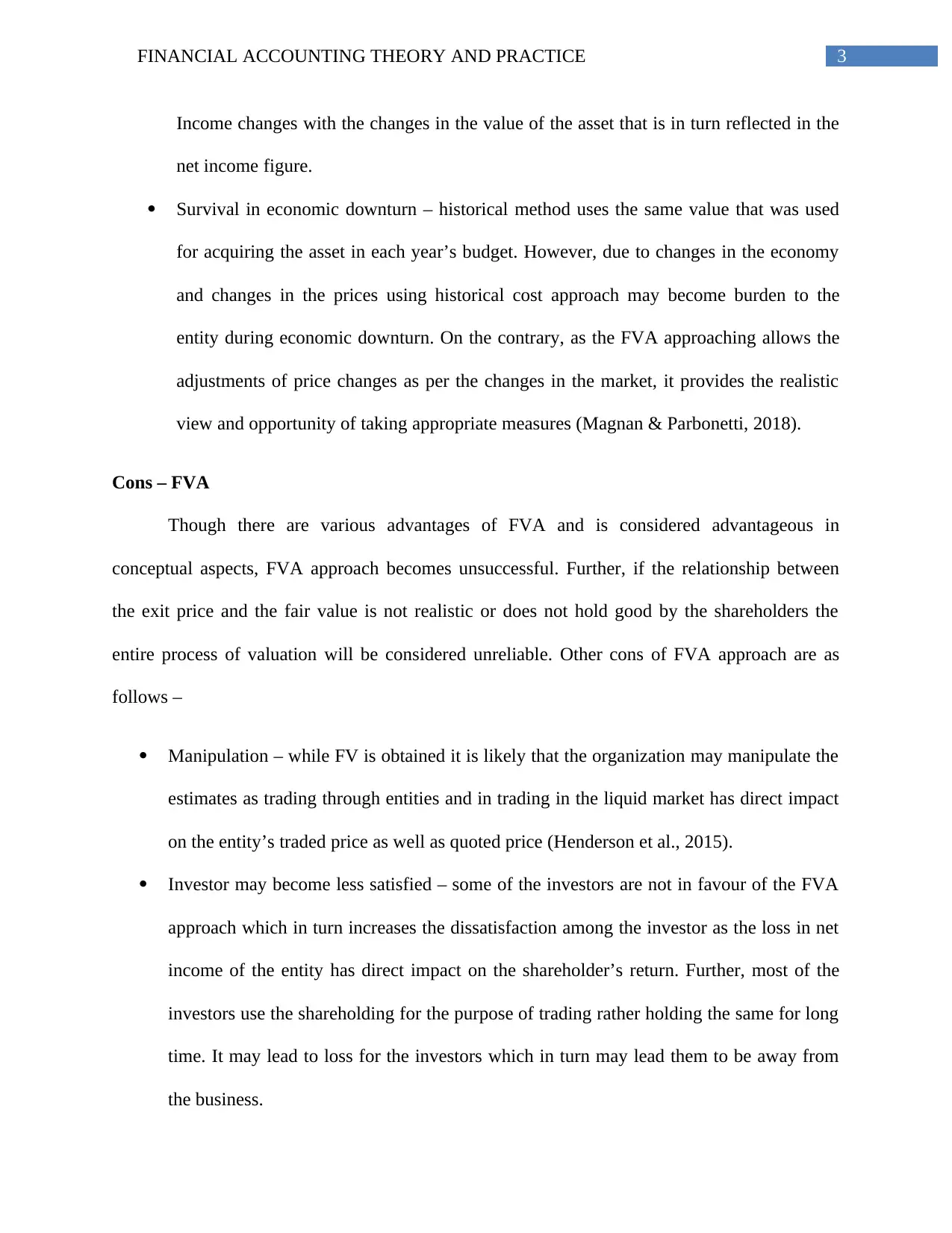
3FINANCIAL ACCOUNTING THEORY AND PRACTICE
Income changes with the changes in the value of the asset that is in turn reflected in the
net income figure.
Survival in economic downturn – historical method uses the same value that was used
for acquiring the asset in each year’s budget. However, due to changes in the economy
and changes in the prices using historical cost approach may become burden to the
entity during economic downturn. On the contrary, as the FVA approaching allows the
adjustments of price changes as per the changes in the market, it provides the realistic
view and opportunity of taking appropriate measures (Magnan & Parbonetti, 2018).
Cons – FVA
Though there are various advantages of FVA and is considered advantageous in
conceptual aspects, FVA approach becomes unsuccessful. Further, if the relationship between
the exit price and the fair value is not realistic or does not hold good by the shareholders the
entire process of valuation will be considered unreliable. Other cons of FVA approach are as
follows –
Manipulation – while FV is obtained it is likely that the organization may manipulate the
estimates as trading through entities and in trading in the liquid market has direct impact
on the entity’s traded price as well as quoted price (Henderson et al., 2015).
Investor may become less satisfied – some of the investors are not in favour of the FVA
approach which in turn increases the dissatisfaction among the investor as the loss in net
income of the entity has direct impact on the shareholder’s return. Further, most of the
investors use the shareholding for the purpose of trading rather holding the same for long
time. It may lead to loss for the investors which in turn may lead them to be away from
the business.
Income changes with the changes in the value of the asset that is in turn reflected in the
net income figure.
Survival in economic downturn – historical method uses the same value that was used
for acquiring the asset in each year’s budget. However, due to changes in the economy
and changes in the prices using historical cost approach may become burden to the
entity during economic downturn. On the contrary, as the FVA approaching allows the
adjustments of price changes as per the changes in the market, it provides the realistic
view and opportunity of taking appropriate measures (Magnan & Parbonetti, 2018).
Cons – FVA
Though there are various advantages of FVA and is considered advantageous in
conceptual aspects, FVA approach becomes unsuccessful. Further, if the relationship between
the exit price and the fair value is not realistic or does not hold good by the shareholders the
entire process of valuation will be considered unreliable. Other cons of FVA approach are as
follows –
Manipulation – while FV is obtained it is likely that the organization may manipulate the
estimates as trading through entities and in trading in the liquid market has direct impact
on the entity’s traded price as well as quoted price (Henderson et al., 2015).
Investor may become less satisfied – some of the investors are not in favour of the FVA
approach which in turn increases the dissatisfaction among the investor as the loss in net
income of the entity has direct impact on the shareholder’s return. Further, most of the
investors use the shareholding for the purpose of trading rather holding the same for long
time. It may lead to loss for the investors which in turn may lead them to be away from
the business.
Paraphrase This Document
Need a fresh take? Get an instant paraphrase of this document with our AI Paraphraser

4FINANCIAL ACCOUNTING THEORY AND PRACTICE
Downward valuation – if due to losses in the asset the entity faces loss of net income, it
may lead to unfavourable situation for entire industry. This may lead to unnecessary
selling due to market volatility. However, in case of historical cost approach the instances
of downward valuation is lower and it will lead more stability for the investors (Magnan,
Menini & Parbonetti, 2015).
Answer 2
Three – tier process in fair value estimation
FVA implementation follows three – tier hierarchies. Dominance factor in determining
the assumption is the governing principle and market value taking into consideration the fact that
the market prices and data will reflect the private information of market participant. Therefore, it
is considered as more reliable against the estimates made internally. Hence, the market price is
considered as the best estimate for estimating the fair value for the scenarios where the prices
efficiently aggregate the information (Marra, 2016). Further, the quality of relevant information
regarding the market prices in evaluated based on the condition of the market condition. For
quantifying the market prices on the basis of fair value estimation it shall be based on the
continuous trading of in adequately liquid market. However, where the market price does not
reflect adequate quality or is not available, the 2nd level estimation is then considered that is the
market value of comparable item. Here the comparability means natural profile of cash flow. If
such price is usable, then the mark-to-market approach fails and FV becomes mandatory that is
to be estimated trough internal estimates and computations. Adequate guidance is there regarding
the valuation model in context of financial instruments and the acceptable methods can be
obtained from the market (Sellhorn & Stier, 2018).
Downward valuation – if due to losses in the asset the entity faces loss of net income, it
may lead to unfavourable situation for entire industry. This may lead to unnecessary
selling due to market volatility. However, in case of historical cost approach the instances
of downward valuation is lower and it will lead more stability for the investors (Magnan,
Menini & Parbonetti, 2015).
Answer 2
Three – tier process in fair value estimation
FVA implementation follows three – tier hierarchies. Dominance factor in determining
the assumption is the governing principle and market value taking into consideration the fact that
the market prices and data will reflect the private information of market participant. Therefore, it
is considered as more reliable against the estimates made internally. Hence, the market price is
considered as the best estimate for estimating the fair value for the scenarios where the prices
efficiently aggregate the information (Marra, 2016). Further, the quality of relevant information
regarding the market prices in evaluated based on the condition of the market condition. For
quantifying the market prices on the basis of fair value estimation it shall be based on the
continuous trading of in adequately liquid market. However, where the market price does not
reflect adequate quality or is not available, the 2nd level estimation is then considered that is the
market value of comparable item. Here the comparability means natural profile of cash flow. If
such price is usable, then the mark-to-market approach fails and FV becomes mandatory that is
to be estimated trough internal estimates and computations. Adequate guidance is there regarding
the valuation model in context of financial instruments and the acceptable methods can be
obtained from the market (Sellhorn & Stier, 2018).
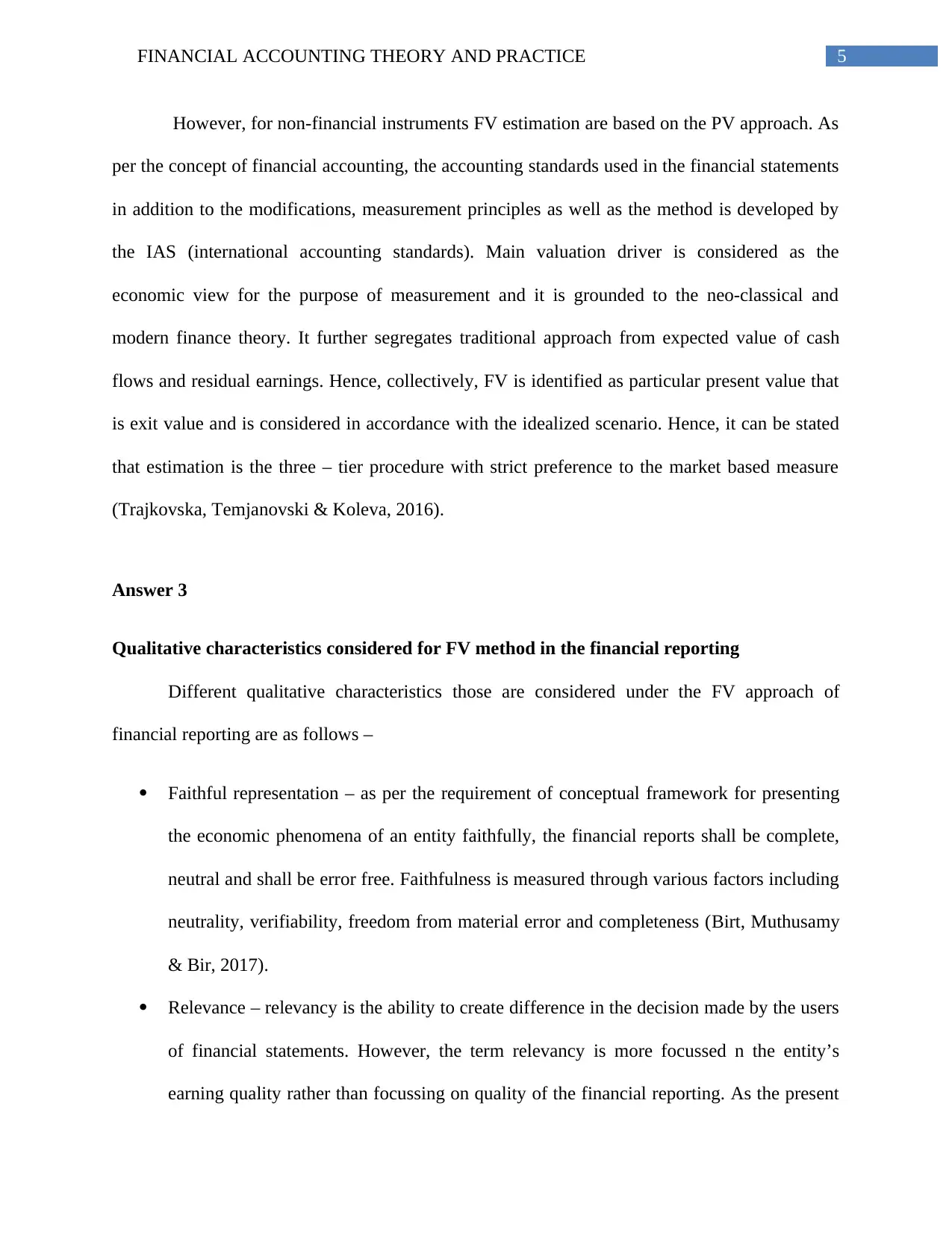
5FINANCIAL ACCOUNTING THEORY AND PRACTICE
However, for non-financial instruments FV estimation are based on the PV approach. As
per the concept of financial accounting, the accounting standards used in the financial statements
in addition to the modifications, measurement principles as well as the method is developed by
the IAS (international accounting standards). Main valuation driver is considered as the
economic view for the purpose of measurement and it is grounded to the neo-classical and
modern finance theory. It further segregates traditional approach from expected value of cash
flows and residual earnings. Hence, collectively, FV is identified as particular present value that
is exit value and is considered in accordance with the idealized scenario. Hence, it can be stated
that estimation is the three – tier procedure with strict preference to the market based measure
(Trajkovska, Temjanovski & Koleva, 2016).
Answer 3
Qualitative characteristics considered for FV method in the financial reporting
Different qualitative characteristics those are considered under the FV approach of
financial reporting are as follows –
Faithful representation – as per the requirement of conceptual framework for presenting
the economic phenomena of an entity faithfully, the financial reports shall be complete,
neutral and shall be error free. Faithfulness is measured through various factors including
neutrality, verifiability, freedom from material error and completeness (Birt, Muthusamy
& Bir, 2017).
Relevance – relevancy is the ability to create difference in the decision made by the users
of financial statements. However, the term relevancy is more focussed n the entity’s
earning quality rather than focussing on quality of the financial reporting. As the present
However, for non-financial instruments FV estimation are based on the PV approach. As
per the concept of financial accounting, the accounting standards used in the financial statements
in addition to the modifications, measurement principles as well as the method is developed by
the IAS (international accounting standards). Main valuation driver is considered as the
economic view for the purpose of measurement and it is grounded to the neo-classical and
modern finance theory. It further segregates traditional approach from expected value of cash
flows and residual earnings. Hence, collectively, FV is identified as particular present value that
is exit value and is considered in accordance with the idealized scenario. Hence, it can be stated
that estimation is the three – tier procedure with strict preference to the market based measure
(Trajkovska, Temjanovski & Koleva, 2016).
Answer 3
Qualitative characteristics considered for FV method in the financial reporting
Different qualitative characteristics those are considered under the FV approach of
financial reporting are as follows –
Faithful representation – as per the requirement of conceptual framework for presenting
the economic phenomena of an entity faithfully, the financial reports shall be complete,
neutral and shall be error free. Faithfulness is measured through various factors including
neutrality, verifiability, freedom from material error and completeness (Birt, Muthusamy
& Bir, 2017).
Relevance – relevancy is the ability to create difference in the decision made by the users
of financial statements. However, the term relevancy is more focussed n the entity’s
earning quality rather than focussing on quality of the financial reporting. As the present
⊘ This is a preview!⊘
Do you want full access?
Subscribe today to unlock all pages.

Trusted by 1+ million students worldwide

6FINANCIAL ACCOUNTING THEORY AND PRACTICE
value of the asset is considered as more appropriate as compared to the purchase price,
FVA is considered as more appropriate as compared to the historical cost approach.
However, in addition to estimated value, confirmatory value also plays important role in
relevancy of the financial information reported in the financial statements (Birt,
Muthusamy & Bir, 2017).
Comparability –the enhancing qualitative characteristics is comparability and is
considered as the quality of information that enables the users to compare the data with
the peers or with the past data of the entity. It is measured by 6 items those are focused on
consistency. Out of 6, 4 items refers to the consistency through using same policies and
process of accounting from specific period to period (Birt, Muthusamy & Bir, 2017).
Understand-ability – financial statement’s understand-ability improves while the
information is differentiated characterized and presented clearly and concisely. It means
the quality of information shall enable the users to comprehend the meaning. It is
measured though evaluating 5 items those highlight transparency as well as clearness of
the presented information in the financial reports (Birt, Muthusamy & Bir, 2017).
Timeliness – another enhancing qualitative characteristic of conceptual framework is
timeliness. It requires that the information shall be available to decision makers before
the ability of the information to influence the decision maker’s decision is lost. Further,
timeliness refers to the time taken by the entity for representing the information that is in
general associated with the usefulness of the decision makers. Further, while the
information quality is analysed from the financial reports, it is measures through the
computation of number of days lapsed between the closing of year and signing of the
report by the auditors (Carcello et al., 2017).
value of the asset is considered as more appropriate as compared to the purchase price,
FVA is considered as more appropriate as compared to the historical cost approach.
However, in addition to estimated value, confirmatory value also plays important role in
relevancy of the financial information reported in the financial statements (Birt,
Muthusamy & Bir, 2017).
Comparability –the enhancing qualitative characteristics is comparability and is
considered as the quality of information that enables the users to compare the data with
the peers or with the past data of the entity. It is measured by 6 items those are focused on
consistency. Out of 6, 4 items refers to the consistency through using same policies and
process of accounting from specific period to period (Birt, Muthusamy & Bir, 2017).
Understand-ability – financial statement’s understand-ability improves while the
information is differentiated characterized and presented clearly and concisely. It means
the quality of information shall enable the users to comprehend the meaning. It is
measured though evaluating 5 items those highlight transparency as well as clearness of
the presented information in the financial reports (Birt, Muthusamy & Bir, 2017).
Timeliness – another enhancing qualitative characteristic of conceptual framework is
timeliness. It requires that the information shall be available to decision makers before
the ability of the information to influence the decision maker’s decision is lost. Further,
timeliness refers to the time taken by the entity for representing the information that is in
general associated with the usefulness of the decision makers. Further, while the
information quality is analysed from the financial reports, it is measures through the
computation of number of days lapsed between the closing of year and signing of the
report by the auditors (Carcello et al., 2017).
Paraphrase This Document
Need a fresh take? Get an instant paraphrase of this document with our AI Paraphraser
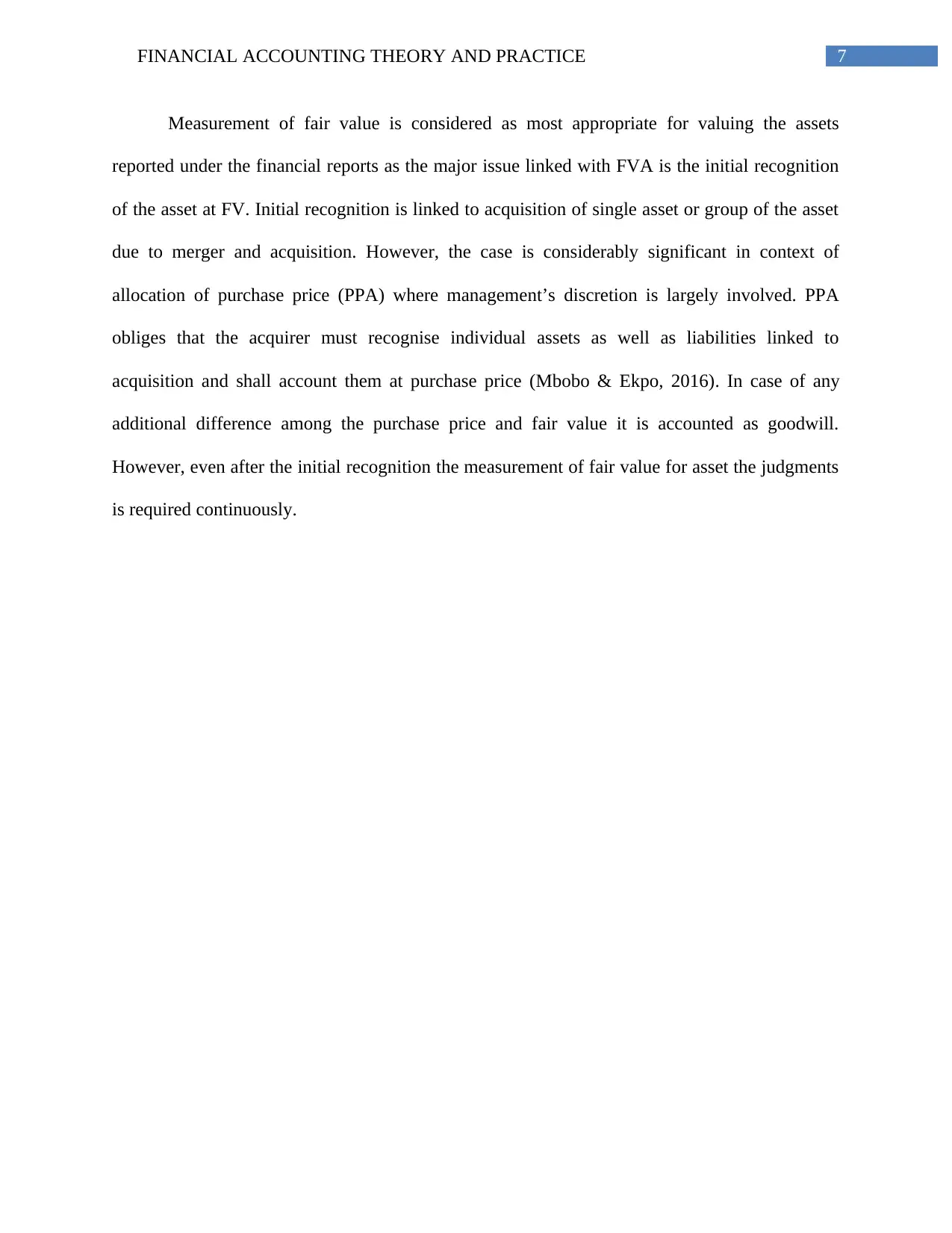
7FINANCIAL ACCOUNTING THEORY AND PRACTICE
Measurement of fair value is considered as most appropriate for valuing the assets
reported under the financial reports as the major issue linked with FVA is the initial recognition
of the asset at FV. Initial recognition is linked to acquisition of single asset or group of the asset
due to merger and acquisition. However, the case is considerably significant in context of
allocation of purchase price (PPA) where management’s discretion is largely involved. PPA
obliges that the acquirer must recognise individual assets as well as liabilities linked to
acquisition and shall account them at purchase price (Mbobo & Ekpo, 2016). In case of any
additional difference among the purchase price and fair value it is accounted as goodwill.
However, even after the initial recognition the measurement of fair value for asset the judgments
is required continuously.
Measurement of fair value is considered as most appropriate for valuing the assets
reported under the financial reports as the major issue linked with FVA is the initial recognition
of the asset at FV. Initial recognition is linked to acquisition of single asset or group of the asset
due to merger and acquisition. However, the case is considerably significant in context of
allocation of purchase price (PPA) where management’s discretion is largely involved. PPA
obliges that the acquirer must recognise individual assets as well as liabilities linked to
acquisition and shall account them at purchase price (Mbobo & Ekpo, 2016). In case of any
additional difference among the purchase price and fair value it is accounted as goodwill.
However, even after the initial recognition the measurement of fair value for asset the judgments
is required continuously.
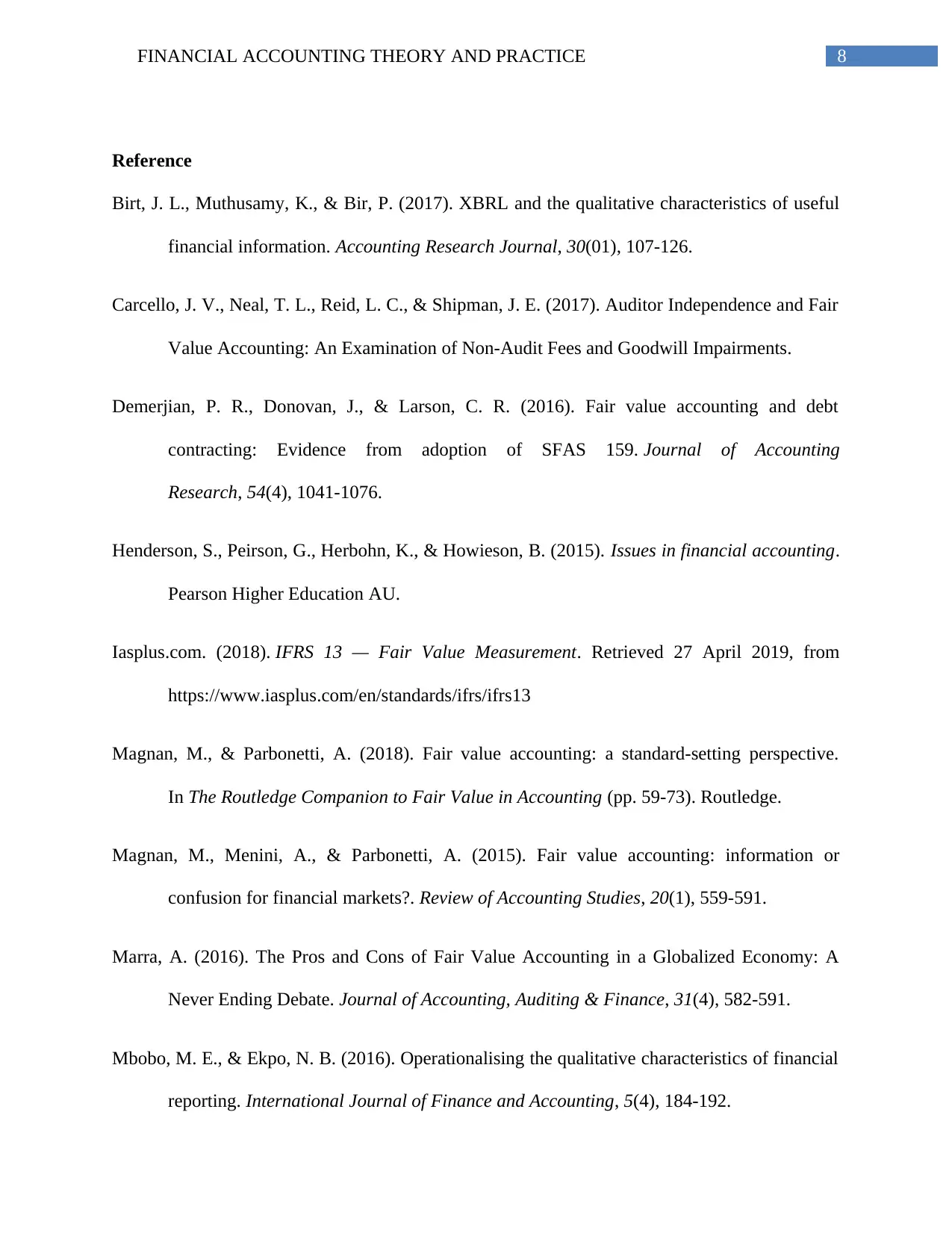
8FINANCIAL ACCOUNTING THEORY AND PRACTICE
Reference
Birt, J. L., Muthusamy, K., & Bir, P. (2017). XBRL and the qualitative characteristics of useful
financial information. Accounting Research Journal, 30(01), 107-126.
Carcello, J. V., Neal, T. L., Reid, L. C., & Shipman, J. E. (2017). Auditor Independence and Fair
Value Accounting: An Examination of Non-Audit Fees and Goodwill Impairments.
Demerjian, P. R., Donovan, J., & Larson, C. R. (2016). Fair value accounting and debt
contracting: Evidence from adoption of SFAS 159. Journal of Accounting
Research, 54(4), 1041-1076.
Henderson, S., Peirson, G., Herbohn, K., & Howieson, B. (2015). Issues in financial accounting.
Pearson Higher Education AU.
Iasplus.com. (2018). IFRS 13 — Fair Value Measurement. Retrieved 27 April 2019, from
https://www.iasplus.com/en/standards/ifrs/ifrs13
Magnan, M., & Parbonetti, A. (2018). Fair value accounting: a standard-setting perspective.
In The Routledge Companion to Fair Value in Accounting (pp. 59-73). Routledge.
Magnan, M., Menini, A., & Parbonetti, A. (2015). Fair value accounting: information or
confusion for financial markets?. Review of Accounting Studies, 20(1), 559-591.
Marra, A. (2016). The Pros and Cons of Fair Value Accounting in a Globalized Economy: A
Never Ending Debate. Journal of Accounting, Auditing & Finance, 31(4), 582-591.
Mbobo, M. E., & Ekpo, N. B. (2016). Operationalising the qualitative characteristics of financial
reporting. International Journal of Finance and Accounting, 5(4), 184-192.
Reference
Birt, J. L., Muthusamy, K., & Bir, P. (2017). XBRL and the qualitative characteristics of useful
financial information. Accounting Research Journal, 30(01), 107-126.
Carcello, J. V., Neal, T. L., Reid, L. C., & Shipman, J. E. (2017). Auditor Independence and Fair
Value Accounting: An Examination of Non-Audit Fees and Goodwill Impairments.
Demerjian, P. R., Donovan, J., & Larson, C. R. (2016). Fair value accounting and debt
contracting: Evidence from adoption of SFAS 159. Journal of Accounting
Research, 54(4), 1041-1076.
Henderson, S., Peirson, G., Herbohn, K., & Howieson, B. (2015). Issues in financial accounting.
Pearson Higher Education AU.
Iasplus.com. (2018). IFRS 13 — Fair Value Measurement. Retrieved 27 April 2019, from
https://www.iasplus.com/en/standards/ifrs/ifrs13
Magnan, M., & Parbonetti, A. (2018). Fair value accounting: a standard-setting perspective.
In The Routledge Companion to Fair Value in Accounting (pp. 59-73). Routledge.
Magnan, M., Menini, A., & Parbonetti, A. (2015). Fair value accounting: information or
confusion for financial markets?. Review of Accounting Studies, 20(1), 559-591.
Marra, A. (2016). The Pros and Cons of Fair Value Accounting in a Globalized Economy: A
Never Ending Debate. Journal of Accounting, Auditing & Finance, 31(4), 582-591.
Mbobo, M. E., & Ekpo, N. B. (2016). Operationalising the qualitative characteristics of financial
reporting. International Journal of Finance and Accounting, 5(4), 184-192.
⊘ This is a preview!⊘
Do you want full access?
Subscribe today to unlock all pages.

Trusted by 1+ million students worldwide
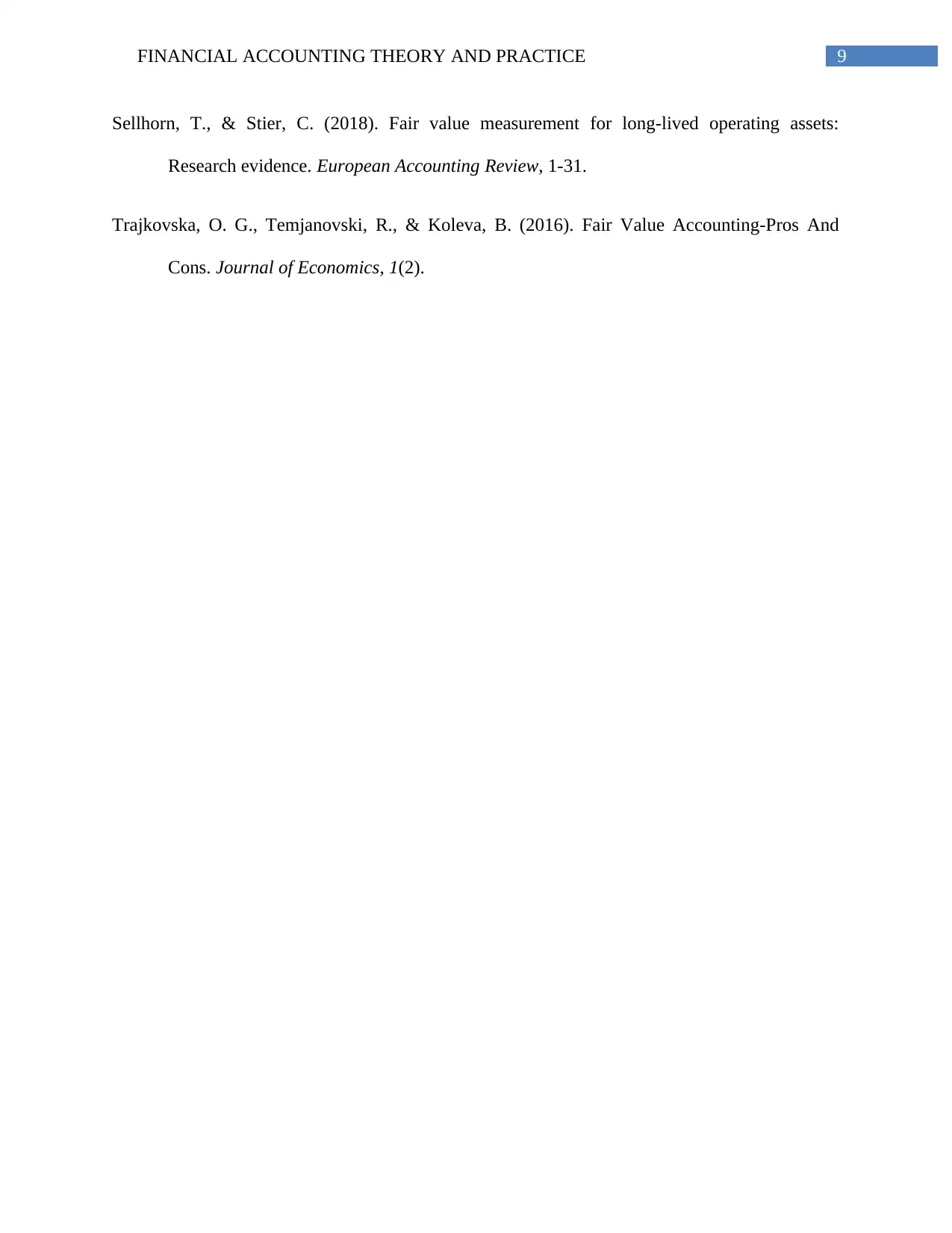
9FINANCIAL ACCOUNTING THEORY AND PRACTICE
Sellhorn, T., & Stier, C. (2018). Fair value measurement for long-lived operating assets:
Research evidence. European Accounting Review, 1-31.
Trajkovska, O. G., Temjanovski, R., & Koleva, B. (2016). Fair Value Accounting-Pros And
Cons. Journal of Economics, 1(2).
Sellhorn, T., & Stier, C. (2018). Fair value measurement for long-lived operating assets:
Research evidence. European Accounting Review, 1-31.
Trajkovska, O. G., Temjanovski, R., & Koleva, B. (2016). Fair Value Accounting-Pros And
Cons. Journal of Economics, 1(2).
1 out of 10
Related Documents
Your All-in-One AI-Powered Toolkit for Academic Success.
+13062052269
info@desklib.com
Available 24*7 on WhatsApp / Email
![[object Object]](/_next/static/media/star-bottom.7253800d.svg)
Unlock your academic potential
Copyright © 2020–2025 A2Z Services. All Rights Reserved. Developed and managed by ZUCOL.




